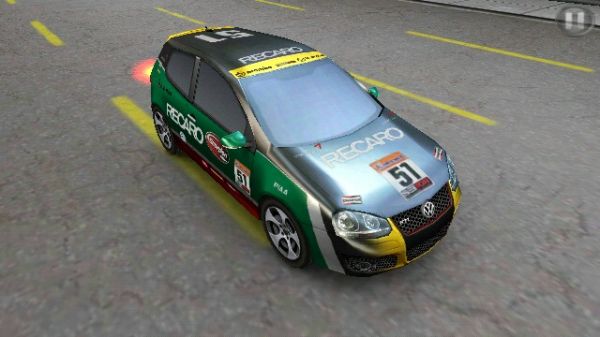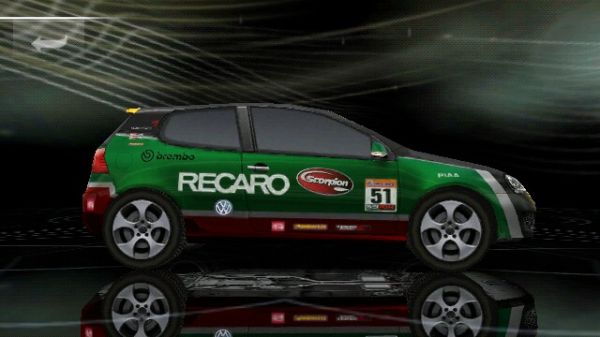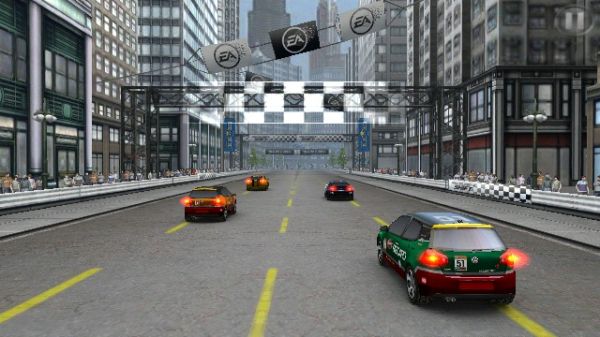Nokia N8 Review: Nokia's New Flagship
by Mithun Chandrasekhar on January 12, 2011 1:00 AM EST- Posted in
- Smartphones
- Nokia
- N8
- Symbian
- Mobile
Look who’s calling the shots…
The N8 represents many firsts for Nokia. It is the first phone to be based on the Symbian^3 platform. It is the first Nokia phone to carry a 12MP camera sensor. It is also the first Nokia phone to have a discrete GPU. And finally, it is the first mainstream Nokia phone to be multi-touch capable (and just the 2nd to have a capacitive screen) and have a GPU accelerated UI, both of which are as a result of switching to Symbian^3. And when it comes to the display and what’s driving it, the Nokia N8 doesn’t disappoint.


NFS Shift HD running on the BMC2727 in the Nokia N8
While I’ll get to the biggest change in the N8 that is the Symbian^3 OS in a while, Nokia has also updated what’s calling the shots behind the scenes. Up until Symbian^3 came along, Nokia rarely ever bothered with including a GPU in its phones and even when it did, it was never really put to any good use. Its last N-Series flagship, the N97, didn’t even have a GPU per se. Except for the Cortex A8-touting outlier that the N900 is, the best that Nokia has done in terms of integrating GPU’s into phones is make use of the OMAP 2420 SoC, which included a PowerVR MBX GPU, in a handful of its previous devices and even this was left mostly unutilized. Things have changed, for the better, with the Nokia N8. Although Nokia is still sticking with a tried and tested ARM 11 implementation for its CPU, it has actually gone ahead and made full use of a discrete Broadcom BCM2727 Multimedia processor for graphic duties. While you can see performance numbers later in the review, the general impression is that it is fairly competent as a GPU.
Nokia’s choice of using an aged ARM 11 implementation, down-clocked to 680 Mhz (instead of the spec’d 772 Mhz) for its CPU may draw criticism in this day and age of gigahertz-capable, multi-core mobile SoC’s. But digging a little deeper seems to show that there may be some method to this madness. You see, pretty much everything in the N8 runs around the BCM2727 media processor. I would hazard a calculated guess that apart from lightweight low-level OS functions and interfacing with the baseband and other radio’s, there isn’t much else for the CPU to do on the N8. Plus, Symbian’s inherently efficient use of available resources helps too.
So what was needed in this case was a low-power, package efficient CPU design that could just about get the job done while sipping as little power and occupying as little space as possible. And this is almost exactly what Nokia found in the Samsung K5WXXXXXXX series of Fusion Memory MCP’s. This MCP (Multi Chip Package) allows Samsung to stack different memory types (DDR, NAND etc.) along with non-memory logic in the same low-power package. So for basically the same footprint as a single memory chip, Samsung is able to integrate the DDR memory (256MB), NAND (512MB) and a CPU (TI ARM11 applications processor).
Most of the heavy lifting in the N8 is done by the BCM2727, as it renders the Symbian^3 UI and games alike, works with the camera module to capture and process 12MP stills and 720p videos, encodes/decodes those videos, drives the HDMI output (upto 720p) and even decodes the audio. So in case of the N8 and Symbian^3, it made sense for Nokia to have a low-power ARM11 CPU coupled with a reasonably powerful and competent multimedia processor. Using an A8 Cortex-based 1Ghz+ part here to run Symbian^3 would have been overkill and power-inefficient. And this decision is quite obvious when you use the N8. The UI is very fluid and responsive with crisp transitions and swift app switching. Furthermore, the N8 posted very competitive battery life numbers to further substantiate Nokia’s decision here.












119 Comments
View All Comments
strikeback03 - Wednesday, January 12, 2011 - link
Off the top of my head (and only looking at US releases since I don't follow the international market that closely) the OG Droid went from 2.0->2.1->2.2, Droid Incredible and Droid X both are on 2.2, think the Evo is as well. Seems like for the most part the devices lagging are Sony-Ericsson (which would seem to be due to their skin) and the Galaxy S phones (which other parts of the world have seen updated, so maybe the US ones will be soon). Remember, a major snag in updating Android is the carriers and their need to test and screw with everything. That wouldn't be a problem for Nokia if they are just selling the phones unlocked and you bring whatever SIM you want.7amood - Wednesday, January 12, 2011 - link
I would like to see similar review of the old Samsung Flagship Galaxy S and the new upcoming flagship (Galaxy S2 A.K.A i9100 or i9200 not sure) that should be announced in MWC2011.I used to be a nokia fan but they are so outdated... no more nokia for me...
maybe I will change my mind when I see MeeGo but until then...
strikeback03 - Wednesday, January 12, 2011 - link
They reviewed the Epic and Fascinate (2 of the US versions of the Galaxy S) and most likely will get some form of the S2 whenever available.Samus - Thursday, January 13, 2011 - link
Nokia is similar to RIM in a lot of ways. They make solid hardware with outdated software. But that isn't a bad thing. Their products are reliable, refined, and built to last. I don't think many people here with HTC and Samsung phones can say the same thing. I simply don't see business users using them. Battery life, reliability, and overall finish keep most people I know who depend on their phones away. Android has great promise, but with the exception of Motorola, who makes good hardware running it?Voldenuit - Thursday, January 13, 2011 - link
I'd add HTC to the list of good handset makers (regardless of OS), although their track record does vary (as does Motorola's). And their Sense UI is a lot more usable than Moto's (horrid) Blur.Samsung puts some cutting edge hardware in its phones but the build quality is often wanting, and the reliability is not good in my experience. My fiancée went through 3 (!) Blackjacks in 2 years, each device would start failing after several months, and she eventually replaced it with a Moto Bravo. She had the option to get a Galaxy S variant (I think it was the Captivate?) but declined due to her negative experience with the brand.
Definitely agree with you about Nokias being built to last. My N70 lasted nearly 4 years, and that was with some nasty drops and bumps. The N8 had a recent nasty fall the other day, and I was very relieved to find it made off without a single nick or scratch (fell onto some metal railings).
jonup - Thursday, January 13, 2011 - link
Most people that look at spec sheets do not get these benefits that Nokia phones have. All these people know is that "My phone has more MHz than yours" and "I want iPhone 4". What is been overlook is that as much as Symbian OS is been bashed it is very efficient OS and does not require as much resources as some other OSes.This review also does not give the phone's excellent standby efficiency justice. Since most of the time the phone is in your pocket, the standby efficiency quite make up for the not so good battery life in the benchmark scenarios in this article. With normal use you would get 3 days out of N8, something out of reach for iPhone 4 or most Androids, which meanwhile have larger battery capacities. Smaller battery allows for use of better quality materials while keeping the weight down.
For all the performance freaks, I recommend to get a Samsung. I have own one and my boss has an Epic, they brake just in time for the newest and the greatest SoC release; which by the lay seems like is every three months now.
To all the N900 lovers, have you seen one? It is literary twice as big as my phone and weights almost 2.5 times. And while solidly built, it still feels too plasticy.
Voldenuit - Wednesday, January 12, 2011 - link
Good job Mithun!I confess that I couldn't wait for the AT review, so I ended up splurging on the N8 a month ago.
Fortunately, I haven't had the issues that you had with the Ovi Store and email - I was able to use the Ovi store on the device just fine, and I have gmail set to 15 minute synchronisations with few problems - it correctly identifies read messages in my inbox, although it will not mark a message that I receive on the phone and then subsequently read on the PC as read.
I've also had no problems with GPS acquisition (using Ovi Maps 3.06) - lock is pretty speedy even in urban areas and accurate enough for turn by turn navigation. I like that you can download maps for offline use, very handy if you're going overseas on a trip, for instance.
As you've outlined, the camera is great, and easily as good as a high end compact, as long as you're happy with a prime lens. In fact, the lens appears sharper to me than the Canon S90's.
Battery life is nothing short of superb. I've just recharged the phone today - the (3rd party) battery monitor app reported the battery at 15% after 5 days and 21 hours of mostly standby and light use (facebooking, email, some calls, some music viewing). With heavy use (Angry Birds, 720p playback, music, internet), I've had to recharge the phone every other day, which is still stellar.
Also worth noting is that there is no need to root the phone to sideload apps, and you can also run java apps compiled for general smartphones. Being a nokia, it is a phone first and foremost, and the call functionality is great - the speakerphone is crisp and clear, handset is great, and there is a LED notification light for missed calls and messages.
When I first purchased the phone, I found the UI took some getting used to compared to, say, iOS, but now that I am accustomed to it, have grown to love the phone. If you think that Nokia is out of contention because of the weak CPU, you might be surprised by how full featured it is. Couple that with top notch build quality, great call quality, a superlative camera, very good battery life, great GPS and navigation apps, and the N8 is a definite contender.
mythun.chandra - Wednesday, January 12, 2011 - link
Good to know you're enjoying your N8!If Nokia keeps to its commitment of updating Symbian^3 on a regular basis, it actually may be a very viable alternative to the other platforms. The only issue as I see is that Nokia does not seem to have a clear cut platform roadmap. They have S40 for the lower-end devices, S^1 for entry-level smartphones, S^3 for the higher-end devices and Meego...well...we're not sure when and how Meego fits in. This, according to me is going to be a problem for Nokia.
Voldenuit - Wednesday, January 12, 2011 - link
Thanks mithun!BTW I notice that mention of the camera is conspicuously absent in the conclusion section. Until the rumored Panasonic Lumix phone appears, the N8 is the best choice for photo enthusiasts on the market, and perhaps some note could be made of that in the recommendations.
For me, at least, it's more attractive than getting a S95 or LX5. Although I lose out on the zoom and capture parameters (you can only control ISO and EV in 0.5 stop steps over a +/- 2 EV range), I end up with a device with a very nice lens, good detail retention, and the ability to edit, geotag and upload my images all from the one device. If you're travelblogging, the N8 makes a very good companion. For reference I have a GF1 and a 40D, so I'm pretty keen on photography, and the N8 has delivered all I could ask of it in a carry-everywhere package.
mythun.chandra - Wednesday, January 12, 2011 - link
From the conclusion page:"With most definitely the best camera ever seen on a mobile phone, the N8 is a worthy replacement to basic point and shoots." :)